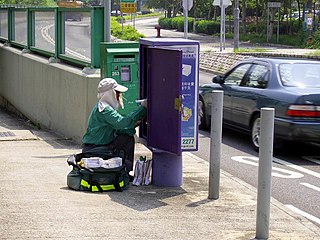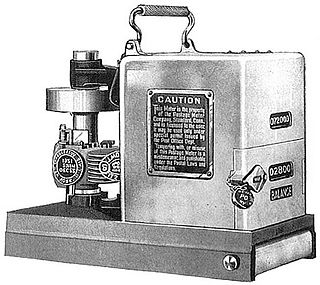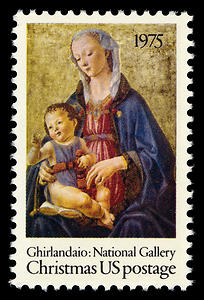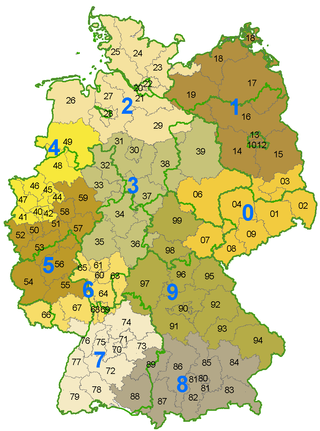This article is intended to give an overview of telecommunications in the Netherlands.

A post office is a public facility and a retailer that provides mail services, such as accepting letters and parcels, providing post office boxes, and selling postage stamps, packaging, and stationery. Post offices may offer additional services, which vary by country. These include providing and accepting government forms, and processing government services and fees. The chief administrator of a post office is called a postmaster.

A postage stamp is a small piece of paper issued by a post office, postal administration, or other authorized vendors to customers who pay postage. Then the stamp is affixed to the face or address-side of any item of mail—an envelope or other postal cover —which they wish to send. The item is then processed by the postal system, where a postmark or cancellation mark—in modern usage indicating date and point of origin of mailing—is applied to the stamp and its left and right sides to prevent its reuse. Next the item is delivered to its addressee.

The United States Postal Service (USPS), also known as the Post Office, U.S. Mail, or Postal Service, is an independent agency of the executive branch of the United States federal government responsible for providing postal service in the U.S., its insular areas, and its associated states. It is one of the few government agencies explicitly authorized by the Constitution of the United States. As of 2023, the USPS has 525,469 career employees and 114,623 non-career employees.

The mail or post is a system for physically transporting postcards, letters, and parcels. A postal service can be private or public, though many governments place restrictions on private systems. Since the mid-19th century, national postal systems have generally been established as a government monopoly, with a fee on the article prepaid. Proof of payment is usually in the form of an adhesive postage stamp, but a postage meter is also used for bulk mailing.

A postal code is a series of letters or digits or both, sometimes including spaces or punctuation, included in a postal address for the purpose of sorting mail.

A ZIP Code is a system of postal codes used by the United States Postal Service (USPS). The term ZIP was chosen to suggest that the mail travels more efficiently and quickly when senders use the code in the postal address.

Postal codes used in the United Kingdom, British Overseas Territories and Crown dependencies are known as postcodes. They are alphanumeric and were adopted nationally between 11 October 1959 and 1974, having been devised by the General Post Office. A full postcode is known as a "postcode unit" and designates an area with several addresses or a single major delivery point.

Postal service in the United States began with the delivery of stampless letters whose cost was borne by the receiving person, later encompassed pre-paid letters carried by private mail carriers and provisional post offices, and culminated in a system of universal prepayment that required all letters to bear nationally issued adhesive postage stamps.

A Canadian postal code is a six-character string that forms part of a postal address in Canada. Like British, Irish and Dutch postcodes, Canada's postal codes are alphanumeric. They are in the format A1A 1A1, where A is a letter and 1 is a digit, with a space separating the third and fourth characters. As of October 2019, there were 876,445 postal codes using Forward Sortation Areas from A0A in Newfoundland to Y1A in Yukon.

There are currently 401 railway stations in the Netherlands including four which are used only during special events and one which serves the National Railway Museum only. NS Stations is the body which manages and owns all railway stations in the Netherlands.
Franking comprises all devices, markings, or combinations thereof ("franks") applied to mails of any class which qualifies them to be postally serviced. Types of franks include uncanceled and precanceled postage stamps, impressions applied via postage meter, official use "Penalty" franks, Business Reply Mail (BRM), and other permit Imprints (Indicia), manuscript and facsimile "franking privilege" signatures, "soldier's mail" markings, and any other forms authorized by the 192 postal administrations that are members of the Universal Postal Union.
Poste restante, also known as general delivery in North American English, is a service where the post office holds the mail until the recipient calls for it. It is a common destination for mail for people who are visiting a particular location and have no need, or no way, of having mail delivered directly to their place of residence at that time.

An address is a collection of information, presented in a mostly fixed format, used to give the location of a building, apartment, or other structure or a plot of land, generally using political boundaries and street names as references, along with other identifiers such as house or apartment numbers and organization name. Some addresses also contain special codes, such as a postal code, to make identification easier and aid in the routing of mail.

A postage meter or franking machine is a mechanical device used to create and apply physical evidence of postage to mailed items. Postage meters are regulated by a country's postal authority. A postage meter imprints an amount of postage, functioning as a postage stamp, a cancellation and a dated postmark all in one. The meter stamp serves as proof of payment and eliminates the need for adhesive stamps.

Non-denominated postage is a postage stamp intended to meet a certain postage rate, but printed without the denomination, the price for that rate. They may retain full validity for the intended rate, regardless of later rate changes, or they may retain validity only for the original purchase price. In many English-speaking countries, it is called non-value indicator or non-value indicated (NVI) postage. Introduced to reduce the cost of printing large issues of low-value stamps to "top-up" old issues, NVI stamps are used in many countries.

The Bangladesh Post Office also known by trade name Bangla Post is a government-operated agency responsible for providing postal services in Bangladesh. It is a subsidiary of the Ministry of Posts, Telecommunications and Information Technology. This ministry is concerned with the policymaking for its two attached departments. The Director General of Bangladesh Post Office is Md Harunur Rashid.

Germany introduced postal codes on 25 July 1941, in the form of a two-digit system that was applied initially for the parcel service and later for all mail deliveries. This system was replaced in 1962 in West Germany by a four-digit system; three years later East Germany followed with its own four-digit system. Whereas the Federal Republic introduced a system with space left for the East German postal system after a possible reunification, such as by omitting all codes starting with '1' and '9', the German Democratic Republic had a system that used all codes starting from '1' to '9' just for East Germany.

The Caribbean Netherlands is a geographic region of the Netherlands located outside of Europe, in the Caribbean, consisting of three so-called special municipalities. These are the islands of Bonaire, Sint Eustatius and Saba, as they are also known in legislation, or the BES islands for short. The islands are officially classified as public bodies in the Netherlands and as overseas territories of the European Union; as such, European Union law does not automatically apply to them.

PostNL, formerly TNT N.V., is a mail, parcel and e-commerce corporation with operations in the Netherlands, Germany, Italy, Belgium, and the United Kingdom. It provides universal delivery in the Netherlands, and is publicly listed at Euronext Amsterdam. The company was known as TNT NV until TNT Express was separated from it in May 2011, and the remainder of the company was renamed PostNL.

















